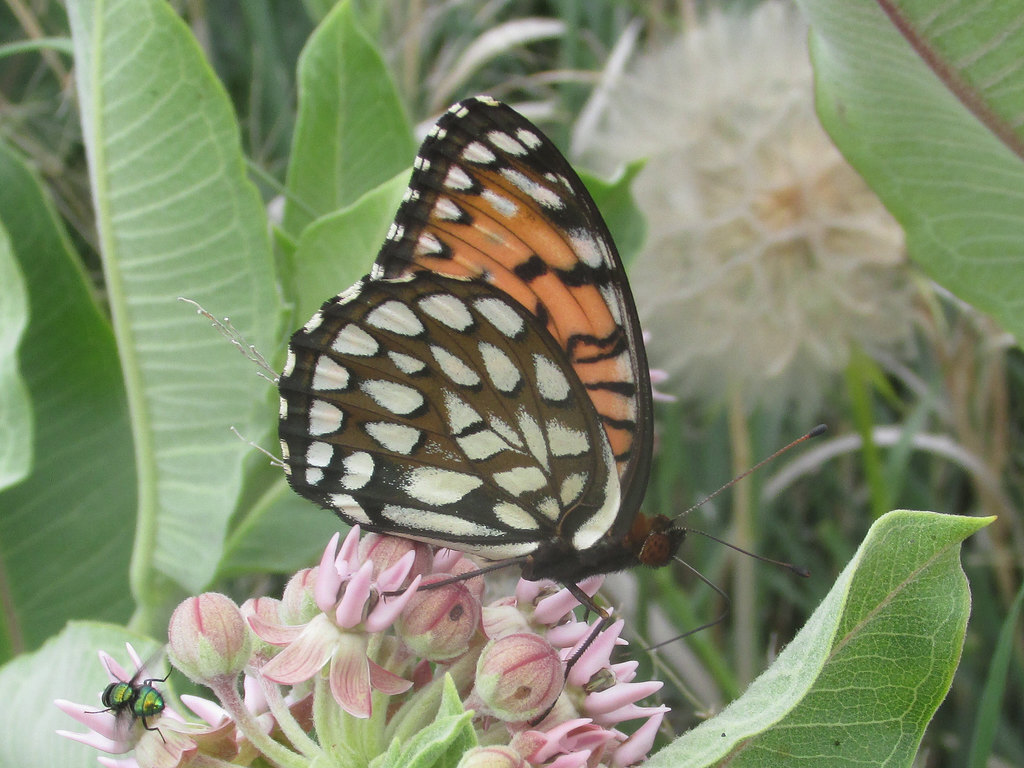Brust's regal fritillaries article published

CHADRON – In an article published in The Journal of the Lepidopterists' Society, Chadron State College Professor of Biology Dr. Mathew Brust, and co-authors Stephen M. Spomer and William Bergman, share years of observation about the regal fritillary butterfly of western Nebraska including two main tactics it uses to survive and propagate. First, the butterfly produces an extremely high number of eggs, and second, it tends to be nomadic, depending on rainfall and resulting habitat.
“Their reproductive biology is really what seems to set regal fritillaries apart from other butterflies. This has been shrouded in mystery for years. Females tend to disappear from about mid-July until mid-August. They seem to hide in the grass and then about late August, early September, they start flying again and they look pretty fresh,” Brust said.
Brust said Brian Kopper and two associates from Kansas State University did a study in 2000 where they discovered the female fritillaries use what they coined as the “sweepstakes method” where they lay eggs randomly in the grassland in low areas, regardless of the plant species, although the preferred food of the regal fritillary caterpillar stage is violets.
“The caterpillars’ fates depends on if they find enough violets to eat. Now that seems a risky way to reproduce, and it requires a very heterogeneous landscape. If that method is going to work, they need a lot of eggs,” Brust said.
In the article, Brust, Spomer, and Bergman recorded more than 1,000 eggs from each of two regal fritillary females, which is unusual compared to most butterflies that lay about 50 to 300 eggs.
“This may be why the females sit dormant for a month because that's a lot of eggs to incubate, which, again, makes them unique,” Brust said. “How far do these females wander when they're laying eggs? We're not sure, but we think possibly 50 to 100 miles or more. Nobody has done a mark-recapture study to say for certain.”
Its seemingly nomadic behavior has serious conservation implications, according to Brust.
“This is a very sensitive species prone to fluctuations in numbers, and its habitat shifts over time due to factors beyond our control, which makes it a much more sensitive species to environmental change than we ever thought,” Brust said.
While doing a study for the state of Nebraska a few years ago when the species was proposed for federal endangered species status, Brust was sent to survey sites across central and western Nebraska where they had been seen before, and he did not find any at some sites. Conversely, he found them for the first time at sites in Thomas, Dawes and Sioux counties. The species was proposed as endangered in 2013, but the results are still pending, according to Brust.
“I started to realize these things move around a lot, and it even got more interesting. A female on the Rosebud or the Pine Ridge Reservation had mated with a male of another fritillary species and produced hybrid offspring. There have also been recent observations of individuals far from any previously known populations or suitable habitat such as tallgrass prairie. With this, defining populations becomes very difficult,” Brust said.
Brust said the good news is that the species that can bounce back and re-populate quickly with proper habitat management.
“In the eastern part of the United States, where they do fire management and keep nearby tracts unburned, the regal fritillaries rapidly colonize the burned sites. The first year or two after the burn, their populations just explode,” Brust said.
An additional positive note, contrary to past notions, is the regal fritillary can eat a wide variety of violets, low-growing plants that often are out-competed by taller and more aggressive plants.
“In fact, there's even a suggestion they might be able to eat asters. Which, if they can, that's kind of nice and gives them more options,” Brust said.
He had not heard of regal fritillaries in or near Chadron before 2017, but his former colleague Dr. Randy Lawson saw one fly through his yard.
“Later that year, I had one fly over my house. The next fall, I had a female spend two days in my yard nectaring on sedum. She was really beat up, clearly done laying her eggs. I was able to take whole series of photographs of her. It makes you wonder how far these things wander,” Brust said.
Related articles:
Brust co-authors journal article about sagebrush buck moth
CSC houses extensive invertebrate collection
Brust co-authors tiger beetle field guide
Brust helps create grasshopper app
Brust publishes paper about newly discovered grasshopper
Brust's tiger beetle research published
—Tena L. Cook, Marketing Coordinator
Category: Campus News
